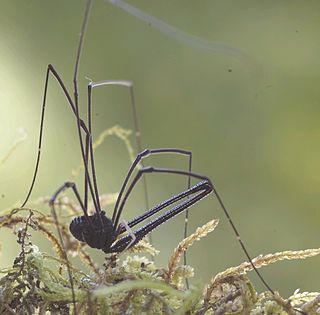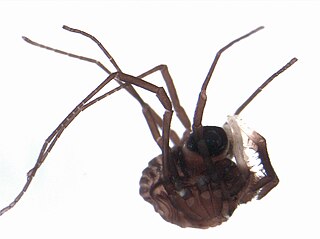
Cosmetidae is a family of harvestmen in the suborder Laniatores. With over 700 species, it is one of the largest families in Opiliones. They are endemic of the New World with a Nearctic-Neotropical distribution where a large fraction of the diversity of Opiliones are represented by this single family. Cosmetidae have the northern extent of their range into the USA, where a small number species occur in the southern states. However, the family is especially diverse in Mexico, Central America and northern South America; especially the Andean realms. Their range also extends further south into Argentina and southern Brazil, but they are absent in Chile. Cosmetidae are prevalent in Amazonian region, but only relatively few also occur in Brazilian Atlantic Forest. Several species are also found in the Caribbean.

The Eupnoi are a suborder of harvestmen, with more than 200 genera, and about 1,700 described species.

The Neopilionidae are a family of harvestmen.

Caddoidea superfamily of harvestmen arachnids with a single family Caddidae, which now only contains 2 extant species. The family previously contained many more taxa under a previous wider concept, but the familial definition was narrowed after restudy.
The Stygnidae are a family of neotropical harvestmen within the suborder Laniatores.

The Cranaidae are a family of neotropical harvestmen within the suborder Laniatores.
The Icaleptidae are a small family of neotropical harvestmen within the suborder Laniatores. Although only two species have been described, many more are probably to be discovered.
Escadabiidae is a small neotropical family of the harvestman infraorder Grassatores with six described species.
Kimulidae is a small neotropical family of the harvestman infraorder Grassatores with about thirty described species.
The Fissiphalliidae are a small monotypic neotropical family of harvestmen within the suborder Laniatores, superfamily Zalmoxoidea. It contains only the single genus FissiphalliusMartens, 1988 with seven described species. All species are found in the South America.
Eutimesius is a genus of harvestmen in the family Stygnidae with five described species. All species are found in South America.
Arhesiro clousi is a species of mite harvestman in the family Sironidae.. It is found in North America, specifically USA, Oregon, Lincoln County.
Arhesiro sonoma is a species of mite harvestman in the family Sironidae. It is found in North America, specifically USA, California, Sonoma County.
Paramiopsalis is a genus of harvestmen belonging to the family Sironidae. All species are found in Spain.
Parasiro is a genus of harvestmen belonging to the family Parasironidae with one described species. It is found in Southwestern Europe.

Rakaia is a genus of harvestmen in the family Pettalidae with eighteen described species. All species are found in New Zealand.
Asarcus is a genus of harvestmen in the family Gonyleptidae with four described species. All species are found in Brazil.
Bourguyia is a genus of harvestmen in the family Gonyleptidae with four described species. All species are found in Brazil.
Imeri is a genus of harvestmen in the family Stygnidae with two described species. Both species are found in Brazil in the state of Amazonas.
Spaeleoleptes is a genus of harvestmen in the family Escadabiidae with two described species. Both species are found in Brazil as cave endemics.





